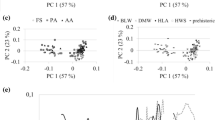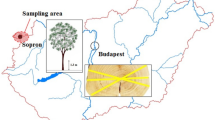Summary
Some fossil woods, differing in botanical species, age, degree of degradation and chemical composition, were analysed with respect to their acid structure. A comparison was carried out with corresponding modern species which, in the case of softwoods, contain carboxylic groups as well as ester groups in almost equal amounts. Moreover the former are subdivided into protonated (∼20%) and salified forms (≈80%). The determination of the acid structures in woods was made by means of cation exchange measurements.
In all examined fossils the initially protonated form is changed into the salified one because of the leaching carried out by water containing soluble salts. Despite the loss of polyoses, an increase in the content of carboxylic groups was achieved due to hydrolysis of the ester groups. In more degraded samples the amount of carboxylic groups was larger than in the other fossils even if the former possessed only traces of polyoses due to an attack on lignin assessed by acidity of the trifluoroacetic (TFA) derivatives. Proof of these changes and further information on fossils were obtained by I.R. spectroscopy.
Similar content being viewed by others
References
Biondi, E.; Brugiapaglia, E.; Rossi, V.; Staccioli, G. 1996: Analisi xilotomica e chemotassonomica di legni fossili rinvenuti in un giacimento del Valdarno superiore. In preparation
Browning, B. L. 1967: Methods of Wood Chemistry. Interscience Publishers. John Wiley & Sons, New York. pp. 405–406
Faix, O. 1992: Methods in Lignin Chemistry. Lin, S. Y.; Dence, C. W., “Fourier Transform Infrared Spectroscopy,” Springer Verlag, Berlin. p. 91
Fengel, D.;Grosser, D.;Wegener, U. 1973: Anatomische und chemische Untersuchungen an zwei fossilen Nadelhoelzern. Palaentographica B 144: 31–43
Fengel, D. 1991: Aging and fossilization of wood and its components. Wood Sci. Technol. 25: 153–157
Fengel, D.;Wegener, G.;Feckel, J. 1981: Beitrag zur charakterisierung analytischer und technischer Lignine. Holzforschung 35: 51–57
Matteoli, U.;Menchi, G.;Staccioli, G.;Tamburini, U. 1992: Acid groups structure in wood as shown using selective reduction. Holz Roh- Werkstoff 50: 438–440
Menchi, G.;Matteoli, U.;Staccioli, G.;Fengel, D. 1995: Long term degradation of terpenes from a 20 million years oldTaxodioxylon gypsaceum. Holzforschung 49: 394–396
Staccioli, G.;Mellerio, G.;Bambagiotti Alberti, M. 1993: Investigation on terpene-related hydrocarbons from a Pliocenic fossil wood. Holzforschung 47: 339–342
Staccioli, G.;Seraglia, R.;Traldi, P.;Menchi, G.;Matteoli, U. 1994: Nature of terpenoids of aTaxodioxylon gypsaceum from the fossil forest of Dunarobba (Italy). Holz Roh- Werkstoff 52: 39–41
Staccioli, G.;Menchi, G.;Matteoli, U. 1996:Taxodioxylon gypsaceum as parent botanical species of two lignites of central Italy. Holz Roh- Werkstoff 54: 259–261
Author information
Authors and Affiliations
Additional information
The authors wish to thank Prof. D. Fengel for the fossils coming from Wackersdorf (Germany)
Rights and permissions
About this article
Cite this article
Menchi, G., Matteoli, U. & Staccioli, G. Changes in the acid structure of wood due to ageing and fossilisation processes. Wood Sci.Technol. 31, 391–397 (1997). https://doi.org/10.1007/BF01159157
Received:
Issue Date:
DOI: https://doi.org/10.1007/BF01159157




